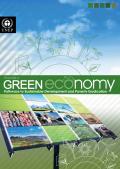
The Green Economy Report is compiled by UNEP’s Green Economy Initiative in collaboration with economists and experts worldwide. It demonstrates that the greening of economies is not generally a drag on growth but rather a new engine of growth; that it is a net generator of decent jobs, and that it is also a vital strategy for the elimination of persistent poverty. The report also seeks to motivate policy makers to create the enabling conditions for increased investments in a transition to a green economy.
The report includes chapters on the following areas:
- Agriculture
- Fisheries
- Water
- Forests
- Renewable Energy
- Manufacturing
- Waste
- Buildings
- Transport
- Tourism
- Cities
- Modelling
- Finance
Sustainable Materials Management (SMM) is increasingly recognised as a policy approach that can make a key contribution to green growth and the challenges that are posed by sustained global economic and demographic growth. One of the key challenges of the SMM approach is to effectively address the environmental impacts that can occur along the life-cycle of materials, which frequently extends across borders and involves a multitude of different economic actors.
This book outlines a series of policy principles for SMM, examines how to set and use targets for SMM, and explores various policy instruments for SMM. In addition it provides examples of policy action plans from the UK and the Netherlands, before presenting a series of conclusions and recommendations.
Every day, unsustainable patterns of consumption, unsustainable production methods and population growth challenge the resilience of the planet to support human activities. At the same time, inequalities between and within societies remain high leaving billions with unmet basic human needs and a disproportionate vulnerability to global environmental change. To counteract this trend, UNEP and SETAC have worked together to develop the current work Towards a Life Cycle Sustainability Assessment. This has been achieved through the UNEP/SETAC Life Cycle Initiative.
A key objective of the UNEP/SETAC Life Cycle Initiative is to help extend life cycle assessment (LCA) methods and practices. One major achievement has been the development of methods and techniques that can measure sustainability and allow LCA to support decision-making toward more sustainable product and process systems. In this way, life cycle techniques can be used to carry out life cycle sustainability assessments. This guidance document provides a starting point for learning about the methodologies and techniques suitable for life-cycle-based ways of measuring sustainability.
